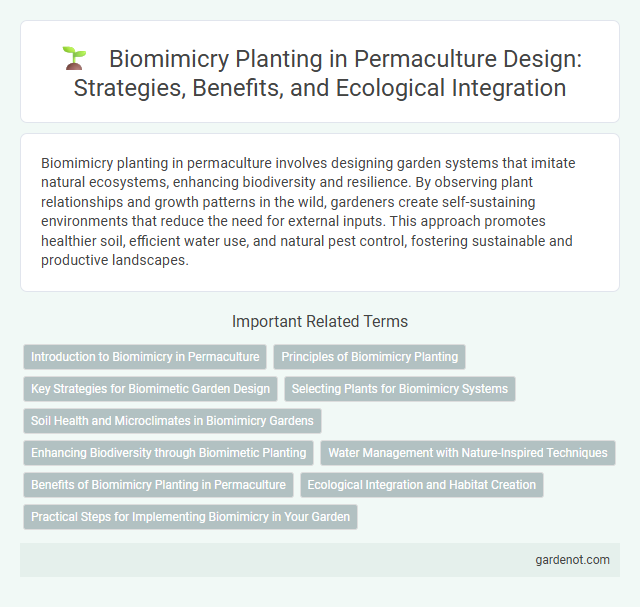Biomimicry planting in permaculture involves designing garden systems that imitate natural ecosystems, enhancing biodiversity and resilience. By observing plant relationships and growth patterns in the wild, gardeners create self-sustaining environments that reduce the need for external inputs. This approach promotes healthier soil, efficient water use, and natural pest control, fostering sustainable and productive landscapes.
Introduction to Biomimicry in Permaculture
Biomimicry in permaculture involves designing agricultural systems inspired by natural ecosystems and the strategies organisms use to thrive. By emulating patterns such as nutrient cycling, water retention, and symbiotic plant relationships, biomimicry enhances soil health, biodiversity, and resource efficiency. This approach promotes sustainable food production by aligning human practices with ecological principles.
Principles of Biomimicry Planting
Biomimicry planting in permaculture harnesses nature's time-tested patterns and strategies, emphasizing principles such as resilience, resource efficiency, and interspecies synergy. By replicating natural ecosystems, it prioritizes diverse plant layers, nutrient cycling, and adaptive growth to create sustainable, self-regulating environments. This approach enhances soil health, promotes biodiversity, and maximizes productivity while minimizing external inputs in permaculture design.
Key Strategies for Biomimetic Garden Design
Biomimicry planting in permaculture gardens employs key strategies such as replicating natural ecosystems by selecting native plant species that thrive in local conditions, promoting biodiversity and resilience. Designing layered plant structures mimics forest strata, optimizing light capture and nutrient cycling while supporting diverse habitats. Integrating water management techniques inspired by natural water flow patterns enhances soil moisture retention and reduces erosion.
Selecting Plants for Biomimicry Systems
Selecting plants for biomimicry systems in permaculture involves choosing species that naturally complement each other's functions, such as nitrogen-fixing legumes paired with deep-rooted perennials to enhance soil fertility and water retention. Incorporating native plants adapted to local climate and soil conditions increases system resilience and reduces maintenance. Plant diversity emulates natural ecosystems, promoting pest control and nutrient cycling while supporting beneficial insects and wildlife.
Soil Health and Microclimates in Biomimicry Gardens
Biomimicry planting in permaculture enhances soil health by mimicking natural ecosystems, promoting diverse plant roots that increase organic matter and microbial activity. This approach creates microclimates that regulate temperature and moisture, benefiting plant growth and reducing erosion. Integrating native species and layering vegetation supports nutrient cycling and stabilizes soil structure for sustainable garden ecosystems.
Enhancing Biodiversity through Biomimetic Planting
Biomimicry planting enhances biodiversity by imitating natural ecosystems' diversity and resilience, promoting a variety of native species that support pollinators and beneficial insects. This approach fosters complex plant interactions, improves soil health through diverse root systems, and creates habitats for wildlife. Incorporating biomimetic patterns in garden design leads to sustainable nutrient cycles and increased ecosystem stability.
Water Management with Nature-Inspired Techniques
Biomimicry planting in permaculture harnesses natural water management strategies such as swales, keyline design, and rain gardens to optimize soil moisture retention and reduce erosion. These nature-inspired techniques mimic forest ecosystems by directing water flow, promoting infiltration, and sustaining groundwater levels. Implementing biomimetic water management enhances site resilience while maximizing plant health and productivity.
Benefits of Biomimicry Planting in Permaculture
Biomimicry planting in permaculture enhances ecosystem resilience by mimicking natural plant relationships, which improves soil health and water retention. This approach supports biodiversity, creating habitats that attract beneficial insects and pollinators essential for crop productivity. Implementing biomimicry reduces the need for synthetic inputs, leading to sustainable, low-maintenance agricultural systems.
Ecological Integration and Habitat Creation
Biomimicry planting in permaculture emphasizes ecological integration by mimicking natural ecosystems, promoting biodiversity and resilience. This approach fosters habitat creation for native wildlife, supporting pollinators, soil organisms, and beneficial insects essential for ecosystem health. Strategic plant selection and arrangement enhance nutrient cycling and water retention, ensuring sustainable landscape productivity.
Practical Steps for Implementing Biomimicry in Your Garden
Implementing biomimicry in your garden begins with observing natural ecosystems to identify plant relationships and soil health techniques that promote biodiversity and resilience. Incorporate native plant species that naturally thrive in your local climate, mimicking forest layers with ground covers, shrubs, and canopy trees to optimize space and energy flow. Use natural pest control methods like companion planting and integrate water-efficient irrigation systems modeled after natural water cycles to enhance sustainability and reduce maintenance.
Biomimicry planting Infographic

 gardenot.com
gardenot.com